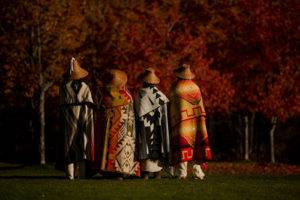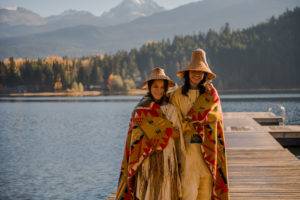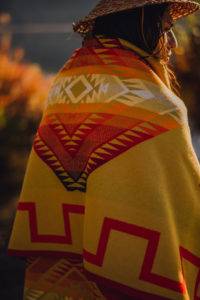
02 Jan The history of blankets & their present use by Squamish & Lil’wat Nations
Blankets have a deeply woven history with Indigenous peoples in North America. Originally created from fur, animal hides, grasses or cedar bark, traders introduced blankets in the 1800s that were lighter and less bulky than traditionally-made blankets, becoming quick preferences amongst Indigenous peoples to make into dresses, skirts, leggings, and jackets. In the Northwest and Plateau areas, the many-coloured Pendleton blankets and shawls have long been favourites and worn in a variety of ways, both for comfort and for style.

From left to right: Navahoe Waters, Journey West, Nike N7, and Spirit Guide are a selection of Pendleton blankets available in our Gift Shop.
In addition to their essential role as clothing, bedding, and protection, blankets were and continue to be elemental in ceremonial practices for Indigenous peoples. In particular to the Squamish and Lil’wat Nations, blankets are integral to ceremonial celebrations such as weddings (when people are blanketed together this signifies that they are now united as one heart, one mind), namings, coming of age, puberty rights, and funerals. If a person is blanketed individually and over their shoulders then they are being honoured – and blankets that are folded and cover half the wearer’s body (over left shoulder and under right arm, covering the heart to keep positive in and negative out) indicates that the wearer has been hired to work on behalf of the family hosting the ceremony.

Cultural Ambassadors Sutikem Bikadi, Lil’wat Nation, and Jay Natrell, Cree and Squamish Nation, pictured here with the Journey West Blanket.
Sometimes, people who are being honoured with a blanket around them are also stood on a blanket as this represents purity.
In honour of the longstanding connection Northwest Indigenous people have with Pendleton blankets, the SLCC Gift Shop carries a variety of designs to keep them readily available to both nations for ceremony. For the month of January, join us in store to purchase your own beautifully woven blanket (Pendleton, Kanata, Native Northwest, and Panabo) for 20% off.

Jay Natrell, Cree and Squamish Nation, wears Pendleton’s Spirit Guide blanket around his shoulders.s
Source:
Hungrywolf, Adolf. (2003) Traditional Dress: Knowledge & Methods of Old-Time Clothing (revised edition). Summertown, TN: Native Voices Book Publishing Company. (available in our gift shop)


Tammy Taylor
Posted at 21:37h, 11 FebruaryI’m a white woman but this was very interesting for me as I feel a kinship to these people as I was born in Squamish B.C. and proud of it!
Mandy Rousseau
Posted at 10:11h, 12 FebruaryHi Tammy Taylor,
The history of blankets in First Nations culture is fascinating, and this only scratches the surface. We’re happy to hear you feel a sense of connection to Squamish Nation, Huy Chexw (thank you, Squamish Language) for sharing this with us :).
Earn Online
Posted at 17:25h, 06 SeptemberI’m extremely impressed with your writing skills and also with the structure to your weblog. Is that this a paid subject or did you modify it yourself? Anyway stay up the nice high quality writing, it’s rare to peer a great blog like this one these days.
Mandy Rousseau
Posted at 08:41h, 16 OctoberWe’re glad you are enjoying your blog 🙂
Soclikes
Posted at 08:26h, 16 OctoberIt is good photo! I like sombrero
Mandy Rousseau
Posted at 08:40h, 16 OctoberWe’re glad you like the photos! The hats aren’t actually sombreros, they are woven inner cedar bark hats 🙂
Krootez
Posted at 07:02h, 01 SeptemberWow, I love patterns like that! It looks very fashionable in 2021. Can’t remember the source but recently I read a post about a native North American artist famous for her basket weaving, she does it with similar patterns and it looks fantastic! Many big brands of today must have been inspired by arts like that.